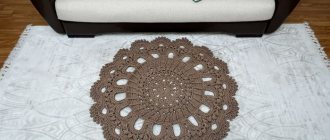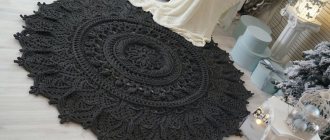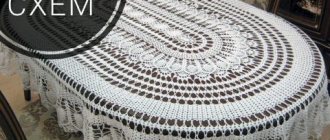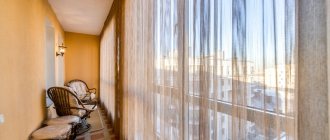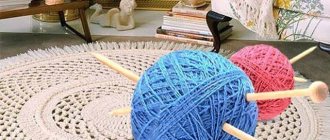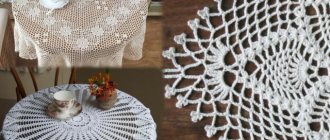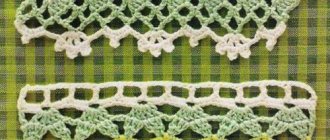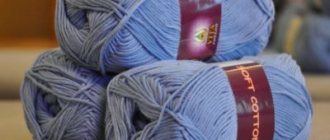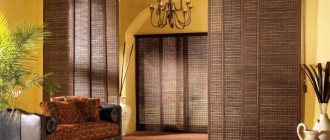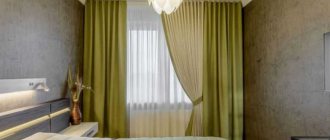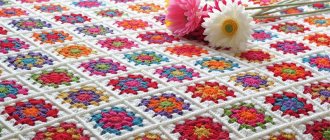Can you crochet? Publish your work on kru4ok.ru
Homemade openwork curtains, crocheted from fine yarn, will become a real decoration of any home, the design of which is close to various vintage, classic or country styles. Such curtains will make any room cozy, adding warmth and light. Over time, it will be possible to decorate other interior details with the same motifs that are found on the curtains, for example, to make napkins or covers for sofa cushions.
Traditionally, it is believed that a knitted curtain is best suited for the kitchen, because a kitchen curtain, as a rule, is more compact than massive long curtains, which means that the pattern on it can be seen in all details.
Where to start knitting curtains
The advantage of knitting is that it does not require large expenses. For knitting you will need a set of hooks, yarn and various patterns. Hooks come in different sizes - sizes from No. 0.5 to No. 8. Its thickness should be two times thicker than the selected yarn. The material is not important; needlewomen choose based on ease of use.
Set of metal hooks
The yarn can be linen, cotton, wool, silk or synthetic. For knitted curtains, natural threads are chosen, so the finished curtains will hold their shape better and will not lose it longer. The number of balls depends on the size of the selected curtain. Very thin yarn will delay the work, and the ornament will be smaller. To roughly determine the size, it is better to knit a small, simple sample.
Curtains are crocheted according to ready-made patterns. They are patterns and ornaments in the form of signs. Symbols are shown in the photo below. Having mastered several patterns, you will be able to knit original models. Kitchen curtains are usually knitted from top to bottom. The work begins with a chain of air loops, the length of which is equal to the width of the future curtain.
Curtains are knitted either in a single fabric or sewn together from individual motifs, for example, a granny square pattern or small round elements. Round parts are knitted from the center, smoothly moving in a spiral.
Colored curtain
Natural materials
Cotton threads of the “iris” type are distinguished by smooth fibers; when crocheting, they do not tangle or curl. This cotton material is dyed in all shades of 7 basic colors. The advantage of these threads is that they do not discolor or fade over time, although they are made of pure cotton.
Linen threads are also 100% natural, but rough and subdued in color. To obtain a richer shade, polyester synthetic fibers are added to them. Linen products have a pronounced texture and are practically impossible to smooth out.
The properties are similar to linen bamboo fibers, but they do not wrinkle and can be ironed perfectly.
Wool threads are distinguished by their elastic strength, which do not wrinkle and stretch well.
Silk threads are distinguished by a full-color palette. Their peculiarity is that, depending on the lighting, the already saturated shades can shimmer with all the colors of the rainbow. They are durable and very durable.
Silk and cotton threads are considered the most suitable for hand-crocheting miniature curtains for the bedroom (or kitchen). If the goal is to knit a large thick curtain, then you need to choose bulky linen or wool threads.
Curtain knitting technology
When working with crochet, various techniques are used, which determine the decorative appearance of the knitted curtain. There are several well-known techniques:
- Sirloin. The fillet technique is based on alternating empty and filled cells, or air loops with columns. The curtain for the kitchen can be knitted in a single fabric or in separate motifs. This is the most popular technique that allows you to work without patterns. With its help, flowers, birds, landscapes are knitted;
- Bruges or Vologda lace. This is a canvas that combines striped braid, background mesh and decorative motifs. The ribbon can be solid or openwork. The result is a reminder of ancient lace made using bobbins;
- Irish. This is a combination of different details placed on a mesh fabric and filling the gaps, for example, leaves, flowers. This technique requires a preliminary pattern, which will help calculate the required number of parts and their position on the grid;
- Broomstick or Peruvian technology. The work is done with a crochet hook and a thick knitting needle. It is knitted into rows of arches, and a different ornament is placed between them. Often, instead of knitting needles, they take a pencil or ruler.
It is better for inexperienced craftswomen to try their hand at the fillet technique, since it is considered simpler than others. Often, an air element called picot is used to finish the edges of the canvas. The curtain with it looks unobtrusive and light.
Choosing a design for different rooms
Each room in an apartment or house carries its own meaning and has a different purpose. Therefore, the design of the curtains should be different. It is important to take into account the direction of the world where the room is located. Rooms located on the south side need a long, tightly knitted fabric that diffuses the direct rays of the sun.
For a kitchen or other non-residential room
Curtains for the kitchen should not only be beautiful, but also practical. Any space in the kitchen can be used as a work surface. This also applies to window sills. Therefore, a better option is a curtain that covers only part of the window. The product will be washed frequently, so the knitting density and quality of the yarn must be appropriate in order to maintain a pleasant appearance longer. The edges of kitchen curtains can be in the shape of leaves or flowers. The bottom is straight or rounded, with tassels and fringe.
All these recommendations apply not only to the kitchen, but also to any non-residential premises.
For the bedroom
Curtains with a complex compositional pattern, falling almost to the floor, will look great in the bedroom. Motifs in the French style, where the canvas is slightly gathered in folds and decorated with fringe or tassels, will fit very harmoniously into the decor.
It is better to knit volumetric curtains from two fabrics, connecting in the middle, which will provide convenient access to the window or balcony. It is allowed to use two or more canvases of different colors. For example, a lighter curtain in close proximity to the window, then a darker one further away.
For children's
Curtains with animals, trees, and fairy-tale characters made using the fillet knitting technique will look great here. In this case, the details of the pattern are knitted more tightly, which makes it possible to do without night curtains.
Curtains “Mysterious cats”
To work you will need:
- White threads (100% cotton, 400 m by 50 g) - 150 g per curtain;
- hook No. 1;
- 12 rings.
Finished curtain size: 40*120 cm
Main ornament:
Cast on the number of loops divisible by 3 + 4 air loops (v.p.) for lifting.
1st row: 1 double crochet stitch in 5 stitches. p. from the hook, then we knit double crochets into the remaining loops.
2nd row: 6 in. p. for lifting, *1 stitch with 2 crochets in 3 stitches with 2 crochets, 2 crochets. p.*, knit from * to *, 1 stitch with 2 crochets in 4 of the sts. lifting point.
3rd row: 6 in. p. for lifting, *1 double crochet in double crochet*, repeat from * to *, 1 double crochet in 4 double crochets. p. We knit this row again.
Knitting density: 15 cells (=45 loops)* 15 rows = 10*10 cm. The diagram below shows two curtains. One square is equal to one cell of the ornament.
On the left is a diagram of 1 curtain, on the right is 2 curtains
Work process:
The work is performed using the fillet technique. For a width of 60 cells, knit 180 in. p. + 4 v. p. for lifting. Then knitting is carried out in accordance with the pattern. Knit 181 rows and finish the work. Straighten the knitted curtain, starch it and steam it a little. Sew rings or ties to the upper edge of the fabric.
Application of metal
Steel clamps are often used for hanging heavy decorative canvases; they do an excellent job and provide maximum reliability and functionality of the structure. The parts themselves have a high service life; you must first pay attention to the quality of the metal when purchasing components.
If a thing is made conscientiously, then during operation it will not rust, otherwise this problem will certainly overtake the owner over time. This unpleasant effect will affect specimens that are located in rooms with high humidity or sudden temperature changes especially quickly.
Floral Curtain
When making curtains for the kitchen from motifs using the Irish technique, a beautiful lace fabric is obtained. This is an easy project, but due to its bulk, it requires more yarn. To work, you need multi-colored or plain yarn of approximately 800 g and hook number 3.
The motif is knitted as follows:
- Make a ring from 8 c. P.;
- 4th century p. for lifting, 23 double crochets in a ring;
- 1st century p. for lifting, 6 in. p., *1 single crochet in 3 double crochets*, repeat from * to * until the end of the circle. Each row ends with a connecting column with the previous one;
- In each resulting arch, knit *3 single crochets, 8 double crochets, 3 single crochets*, repeat from * to * to the end of the row. Finish work;
- Knit the required number of motifs until you get the desired curtain size.
There are different floral motifs. Below are a few different options.
Decorations as an element of kitchen decoration
If you have insufficient knitting experience or, due to your nature, cannot sit in one place for a long time, but the idea of decorating the kitchen interior seems very interesting to you, start with a simple knitting border for a finished curtain.
Even restless housewives will be able to put their talents to work
Knitted decorative elements
Note! Knitted curtain tiebacks will easily refresh a boring kitchen interior.
Openwork curtain “Angels”
For work: thread (100% cotton, 330 m by 50 g) approximately 150 g and hook No. 1-1.25. The size of the finished curtain is 34*80 cm. Knitting density: 17*16 cells or 10*10 cm.
Knitting process: dial 157 v. p. and continue working according to the scheme. In row 132 you need to make loops for the arch plank from c. p.: 3 c. p. instead of 1 double crochet, * 8 in. p., skip 7 loops, double crochet. Continue according to the pattern until the end of the pattern. Knitting is carried out using the fillet technique.
How to crochet beautiful curtains using the Irish crochet technique?
Knitting using the Irish technique is also not easy. As a rule, patterns are laid out on a pre-prepared cloth knitted with a mesh, as in the image below, and then the product is knitted. How to crochet a curtain in Irish style is now clear. But you will have to think about the process in advance so that the patterns are symmetrical and look even. You can use any base, from fillet mesh to decorative.
Crochet Patterns
patterns for curtains using Irish knitting techniques
Curtains "Lace flowers" with scalloped edge
To work you will need:
- Threads (100% cotton, 380 m by 50 g), 350 g;
- Hook No. 1-1.25;
- White sewing threads;
- White cambric – 1.7 m.
Knitting is carried out using the fillet technique with a density of 14.5*14.5 cells or 10*10 cm. Border size: 60*15 cm.
Description of work:
The work begins with the formation of the outer scallops separately, rows from 14 to 74 are knitted across the entire width of the curtain and finished with scallops. For one festoon you need to knit a chain of 29 chains. p. and 4 v. p. for lifting, then knit according to the pattern up to the 12th row, including it. This way you need to knit only 7 festoons.
In the 13th row, all scallops need to be connected, making 3 stitches between them. p. The diagram shows only 5 elements, the rest are knitted in exactly the same way. The final ornament should look symmetrical.
After 74 rows you need to finish the festoons, each separately. Cut out the cambric, trim its edges and sew the border to the curtain.
Knitting pattern for curtains “Lace flowers”
Textiles to match the colors and texture of the walls
This design is suitable for adherents of rigor, conciseness and elegance. What could be easier than choosing curtains to match the color of the walls. Despite all the ease of execution, such textiles look very stylish and modern. Nowadays, notes of minimalism and light carefree are valued. Thanks to this technique, you do not overload the interior, leaving yourself the opportunity to relax after a hard day at work and enjoy the alluring simplicity, without unnecessary complications.
Knitted curtain with openwork butterflies
Curtain size 48*100 cm, butterflies – 9*12 cm each. To work you will need:
- Threads (cotton 100%, 260 m per 50 g) 300 g;
- Hook No. 1.25;
- Satin ribbon;
- Markers for knitting ornaments.
Knitting density 10*10 cm or 18*20 cells.
Markers for making patterns
When working with this model, you need several patterns at once:
- Sirloin knitting. Each cell consists of 3 loops, while each free cell is 1 stitch with one or two crochets and 2 ins. p. A full square is 3 double crochets;
- Pattern for inner motif and top edge;
- Diagram for a butterfly.
Description of work:
Dial 262 v. n. Continue knitting the internal motifs and the top edge according to the second pattern. Starting from the 9th row, knit the upper and lower parts separately. In the 44th row, make a connection using 2 v. p. Then continue whole knitting until the 58th row. The given figure in diagram one must be repeated 4 times. Finish the curtain with a row of double crochets.
Description of work for butterfly:
- The work begins with knitting the body. To do this you need to dial 25 v. p. and turn the knitting.
- Dial 3 v. p. for lifting, knit with double crochets to the end of the row.
- Continue knitting according to the pattern, ending all circles with a connecting stitch.
- Future wings are knitted with loops only behind the back walls.
- Finish the work, leaving a thread 1.5 m long.
- To decorate the lower wing, you need to attach a new thread at arrow 3 in the diagram.
- Dial 30 v. etc., close it into a ring with a connecting post. Knit the wing according to the pattern in the forward and reverse directions.
- For the upper left wing, attach a new thread at arrow 2. Cast on 40 stitches. etc., close it into a ring with a connecting post. Continue knitting according to the pattern in two directions.
- Finish knitting, cut and fasten the thread. Knit the right wing in the same way, only in a mirror way.
- After completing all the work, tie the remaining thread around the body in one row behind the back wall. A total of 8 butterflies are needed.
Curtain assembly:
- Stretch the finished curtain, cover with a cloth slightly moistened with starched water and leave to dry.
- Do the same with butterflies.
- Iron both the curtains and the butterflies.
- Attach the butterflies to green satin ribbons, as in the photo.
Is it advisable to hang blinds in the kitchen?
Having appeared as an element of office decor, due to their practicality, blinds quickly entered residential interiors and have not lost popularity for many years. Housewives value them for their ease of care - the blinds do not need to be washed, you just need to regularly wipe them from dust and grease. Vertical or horizontal, they are equally well suited for various interiors - from hi-tech to classic.
Indispensable for windows facing the sunny side. Closing tightly, they will reliably protect the room from the hot sun. By adjusting the angle of rotation of the plates, you can control the lighting and ventilate the room without opening the blinds completely. In addition to everything, they perfectly hide the room from prying eyes, which is highly appreciated by the owners of apartments on the first floors.
